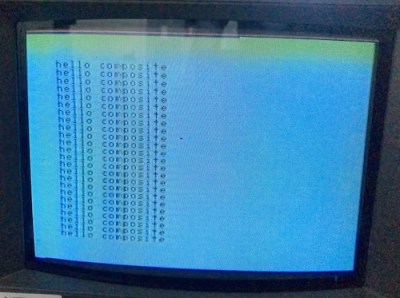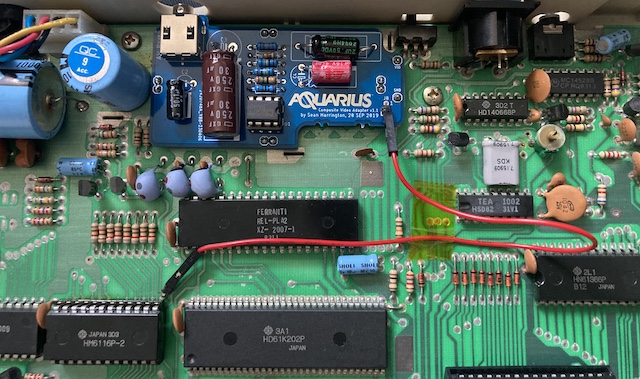In the home computer market of the 1980s, there were several winners that are still household names four decades later: the Commodore 64, the Apple II and the Sinclair Spectrum, to name a few. But where there are winners, there are bound to be losers as well – the Mattel Aquarius being a good example. A price war between the bigger players, combined with a rather poor hardware design, meant that the Aquarius was discontinued just a few months after its introduction in 1983. However, this makes it exactly the type of obscure machine that [Leaded Solder] likes to tinker with, so he was happy to finally get his hands on a neat specimen listed on eBay. He wrote an interesting blog post detailing his efforts to connect this old beast to a modern TV.
The main issue with the Aquarius is that it only has an RF video output, which results in a rather poor rendition of its already very limited graphics capabilities. Luckily, there is a fix available in the form of a composite A/V adapter that’s an almost plug-and-play upgrade. The only thing you need to do, as [Leaded Solder] illustrates in his blog post, is open up the computer, desolder the RF modulator and solder the A/V adapter in its place. Getting to that point was a bit tricky due to heavy EMI shields that were fixed in place with lots of solder, requiring liberal use of a desoldering iron.
 While he had the machine opened up, [Leaded Solder] decided to also replace the original 7805 linear voltage regulator with a switching model, in order to reduce the amount of heat dissipated inside the cramped case. Once all this was done, the Aquarius booted up as usual, but this time with sharp, readible graphics and clear audio.
While he had the machine opened up, [Leaded Solder] decided to also replace the original 7805 linear voltage regulator with a switching model, in order to reduce the amount of heat dissipated inside the cramped case. Once all this was done, the Aquarius booted up as usual, but this time with sharp, readible graphics and clear audio.
Interestingly, Mattel used a type of hardware encryption on its peripheral bus in an attempt to prevent unauthorized third-party extensions. Now that the computer is in a usable state, [Leaded Solder] is planning to reverse-engineer this system and figure out how it worked exactly. We’re definitely looking forward to seeing that, since the only homebrew Aquarius hardware we know of used a software trick to get around the lockout.

















Yeah, it’s a nice product and mod! I’ve installed it too in my Aquarius. There is actually no real need to uninstall the RFI shield. I just left it in place.
I think that was an okay decision. If you ever try to attach a rare computer to a vintage monitor, RF is the safest way.
Because, it uses galvanic insulation by default. Even the oldest TVs have their RF input decoupled with a simple capacitor, because said TVs were so dangerous.
Anyway, nothing against composite. It can be good, depending on the setup. Better vintage video monitors have an analog comb filter, for example.
RF can also be good, especially if its purely monochrome (no color color carrier). If it’s in colour, the bandwidth is a bit limited by the RF format. Full bandwidth is available via composite only (or higher end outputs).
Anyway, it can help to attach ferrites to the AV cable and the power chords, to get rid of RF noise, sheat current etc. There are also video transformers, which can be used for galvanic insulation. They will also prevent ground loops and other noisy phenomena.
I am really shocked by this program. The Aquarius was a really bad system back in the day. It came out after the C-64 and honestly didn’t compete well with the older Vic-20. It has a terrible chicklet keyboard. It had only 4k of ram stock terrible sound and graphics. It came out in June of 1983 and discontinued in October of that same year. Good for keeping this system around and functioning. It failed when launched and for a good reason. But history is history so it is good to see this odd system is getting some attention.
“A CRT TV showing several lines reading “hello composite”While he had the machine opened up, [Leaded Solder] decided to also replace the original 7805 linear voltage regulator with a switching model [..] ”
Thumbs up for the CRT video monitor and CVBS mod, but not for the 7805 replacement. Switching regulators have a low power quality (ripple, RF etc).
The 78 series were among the cleanest regulators, available. In vintage PCs, soundcards used the 12v line via an linear regulator rather than the native 5v rail, exactly because it was more clean. The 78xx/79xx were used as power source cleaners, literally.
Anyway, the good thing about composite/cvbs is that it’s often the “source signal”, anyway. An RF modulator typically uses it as an input signal, along with mono audio (except for the C64 RF modulator module, which is an oddity).
So it really gives best quality, here.
If S-Video (Chroma/Luma) or RGB were used instead, a vital part of the filtering process would have been removed. A bit of blurriness is always needed, so that colours can blend together as intended. A period correct CRT intensifies that experience.
Otherwise, the image is not what the game designers had intended. RGB output rather is good for work, for artists drawing graphics and for progeammers.
The final image, for the user, looks most accurate on a household TV, however. Say, dot pitches of 0.42 at 13″ to 15″. If it’s finer, there will be ugly black scanlines and pixelation visible.
I replaced the 7805 in my Super Nintendo with a cheap little switching regulator, and noticed the image became grainy, looks like static, so I put the 7805 back in. This was with composite and s-video.
I used a switching regulator down to 7V in my Commodore 16, then the linear regulator down to 5V
“The main issue with the Aquarius is that it only has an RF video output, which results in a rather poor rendition of its already very limited graphics capabilities. ”
Or the tuners in modern TVs nolonger can handle a real terrestrial signal. Since cable TV got so popular, stability and sensitivity nolonger is important. There’s no fading anymore, no thunderstorm causing interference. No need for an sophisticated AFC (automatic frequency control) that constantly tunes the channel. Cable TV signals are simple to handle, always good. A broadband tuner is all it needs (or needed, analog cable TV is history).
Another issue is de-interlacing. Old consoles skip a field, which isn’t conform to TV standard. See 240p/288p etc. If RF noise comes into play, it’s even more confusing to a modern TV. Here, composite really is an improvement to the overall experience.
Old consoles skip a field?
What i think you mean is that they show the same image twice, meaning that odd and even fields are both the same.
Truly skipping a field would mean something else and would cause all sorts of issues.
Not exactly. Remember that the NTSC/PAL/SECAM systems were designed to be very cheap to implement in the receptor side. That’s why the lines were slightly diagonal, not perfectly horizontal. To start the odd fields, a horizontal sync was sent right after the vertical sync, so the field begins at the top-left corner; but to star the even field, a vertical sync was sent in the middle of the last line; thus the first line begins at the top-middle section of the screen, and since the lines aren’t horizontal but slightly inclined, the even lines fit perfectly between the previously drawn odd lines.
The 80s computers and consoles, for simplicity, always sent a horizontal sync right after the vertical sync, so only the odd lines were drawn at twice the framerate.
Is this the dawning of the Age of Aquarius?
lol; if but only. got another 90 years
a ROM dump would be most splendid
nevermind; I think I found one via one of the various emulators
That was my first computer. I always wondered who made it and why i had never seen another one. I spent hours typing out the basic from the manual to play games on it as i had no tape drive to save on. The best story is how we got it. My father was a school teacher and we didn’t have a lot of money for “toys” so we would get “toys” from where we could. My Grandmother lived in Norfolk Virginia and in the 80’s they were building timeshare homes in Williamsburg. So in the summer we would visit my Grandmother and stop in Williamsburg and go on the timeshare tours and they would give you a free gift. The Aquarius was one of those gifts. We also got a color tv once, a casio 1″ pocket tv that i still have somewhere. Used it in high school to watch TV in study hall.